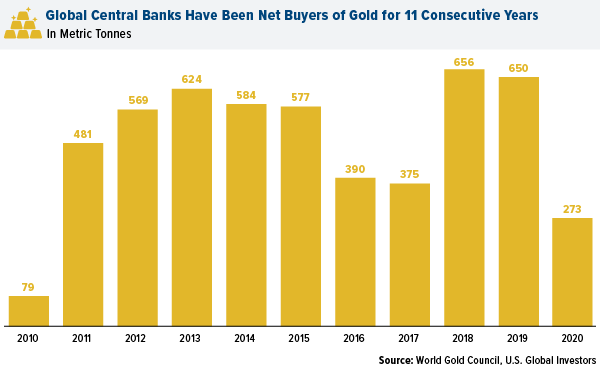

Top 10 Countries with Largest Gold Reserves
Beginning in 2010, central banks around the world turned from being net sellers of gold to net buyers of gold. Central banks around the world bought 272.9 tonnes of bullion in 2020.
Central banks have been net buyers of gold for 11 consecutive years. According to World Gold Council (WGC) data, central banks around the world bought 272.9 tonnes of bullion in 2020.
Purchases last year were a whopping 60% lower than the record 668 tonnes added in 2019. The COVID-19 pandemic was a stronger driver for some central banks to sell reserves and inject liquidity into their economies. Purchasing was concentrated in the first half of the year, then turned nearly nonexistent in the third quarter and resumed in the last three months of the year.
The top 10 central banks with the largest gold reserves have remained mostly unchanged for the last few years. The United States holds the number one spot with over 8,000 tonnes of gold in its vaults – nearly as much as the next three countries combined – and accounting for 79% of total reserves. The only countries where gold represents a higher percent of reserves are Portugal at 80.1% and Venezuela at 82.4%

10 central banks made net purchases of one tonne or more in 2020, highlighting the continued demand for the precious metal. Turkey was the number one buyer for the second straight year – adding 134.5 tonnes – and was also the largest seller after decreasing holdings by 36.3 tonnes. WGC notes sales were concentrated among a small number of central banks that buy gold from domestic production, including Mongolia and Uzbekistan.
Below are the top 10 countries with the largest gold holdings, with the rankings remaining unchanged from 2019. Figures are as of April 2021 and do not include the International Monetary Fund (IMF) as a country, or else it would hold the number three spot with 2,814 tonnes.
10. Netherlands
Tonnes: 612.5
Percent of foreign reserves: 67.4 percent
The Dutch Central Bank announced that it will be moving its gold vaults from Amsterdam to Camp New Amsterdam, about an hour outside the city, citing burdensome security measures of its current location. As many others have pointed out, this seems odd, given that the bank fairly recently repatriated a large amount of its gold from the U.S.

9. India
Tonnes: 687.8
Percent of foreign reserves: 6.5 percent
It’s no surprise that the Bank of India has one of the largest stores of gold in the world. The South Asian country, home to 1.25 billion people, is the second largest consumer of the precious metal, and is one of the most reliable drivers of global demand. India’s festival and wedding season, which runs from October to December, has historically been a huge boon to gold’s Love Trade.

8. Japan
Tonnes: 765.2
Percent of foreign reserves: 3.1 percent
Japan, the world’s third largest economy, is also the eighth largest hoarder of the yellow metal. Its central bank has been one of the most aggressive practitioners of quantitative easing—in January 2016, it lowered interest rates below zero—which has helped fuel demand for gold around the world.

7. Switzerland
Tonnes: 1,040.0
Percent of foreign reserves: 5.4 percent
In seventh place is Switzerland, which actually has the world’s largest reserves of gold per capita. During World War II, the neutral country became the center of the gold trade in Europe, making transactions with both the Allies and Axis powers. Today, much of its gold trading is done with Hong Kong and China.

6. China
Tonnes: 1,948.3
Percent of foreign reserves: 3.3 percent
In the summer of 2015, the People’s Bank of China began sharing its gold purchasing activity on a monthly basis for the first time since 2009. Although China comes in sixth for most gold held, the yellow metal accounts for only a small percentage of its overall reserves – a mere 3.3 percent. As of 2021, China will now allow domestic and international banks to import large amounts of the precious metal into the country in an effort to support prices. According to reporting by Reuters, an estimated 150 metric tons worth $8.5 billion will be shipped into China as soon as April or May.

5. Russia
Tonnes: 2,295.4
Percent of foreign reserves: 22.0 percent
The Russian Central Bank has been one of the largest buyers of gold for the past seven years and overtook China in 2018 to have the fifth largest reserves. In 2017, Russia bought 224 tonnes of bullion in an effort to diversify away from the U.S. dollar, as its relationship with the West has grown chilly since the annexation of the Crimean Peninsula in mid-2014. To raise the cash for these purchases, Russia sold a huge percentage of its U.S. Treasuries.

4. France
Tonnes: 2,436.0
Percent of foreign reserves: 64.5 percent
France’s central bank has sold little of its gold over the past several years. Current reserves consist of 100 tonnes of gold coins and the rest in bars weighing around 12.5 kilograms each. The Banque de France vaults in Paris are one of the four designated depositories of the International Monetary Fund (IMF).

3. Italy
Tonnes: 2,451.8
Percent of foreign reserves: 69.3 percent
Italy has likewise maintained the size of its reserves over the years. Mario Draghi, the former Bank of Italy governor and European Central Bank governor, when asked by a reporter in 2013 what role gold plays in a central bank’s portfolio, answered that the metal was “a reserve of safety,” adding, “it gives you a fairly good protection against fluctuations against the dollar.”

2. Germany
Tonnes: 3,362.4
Percent of foreign reserves: 74.5 percent
In 2017 Germany completed a four-year repatriation operation to move a total of 674 tonnes of gold from the Banque de France and the Federal Reserve Bank of New York back to its own vaults. First announced in 2013, the move was expected to take until 2020 to complete. Although gold demand fell in 2017 after hitting an all-time high in 2016, this European country has seen gold investing steadily rise since the global financial crisis.

1. United States
Tonnes: 8,133.5
Percent of foreign reserves: 77.5 percent
With the largest official holdings in the world, the U.S. lays claim to nearly as much gold as the next three countries combined. It also has the third highest gold allocation as a percentage of its foreign reserves. From what we know, the majority of U.S. gold is held at Fort Knox in Kentucky, with the remainder held at the Philadelphia Mint, Denver Mint, San Francisco Assay Office and West Point Bullion Depository. Which state loves gold the most? Well, the state of Texas went so far as to create its very own Texas Bullion Depository to safeguard investors’ gold.

What’s happening with gold this week? Read our Investment teams’ weekly analysis here.
All opinions expressed and data provided are subject to change without notice. Some of these opinions may not be appropriate to every investor. By clicking the link(s) above, you will be directed to a third-party website(s). U.S. Global Investors does not endorse all information supplied by this/these website(s) and is not responsible for its/their content.































